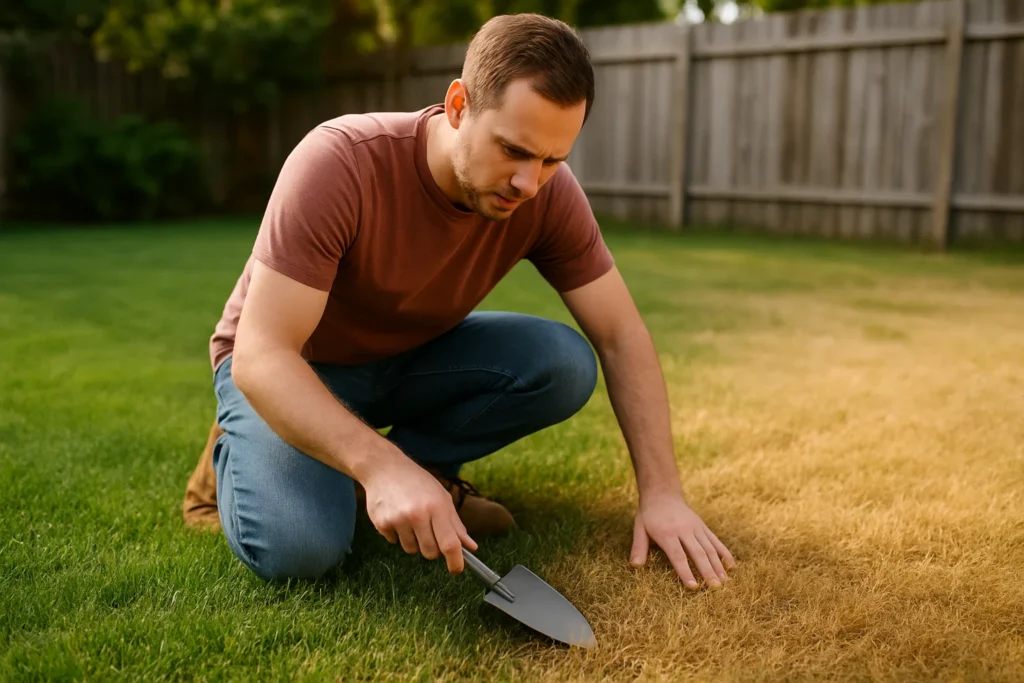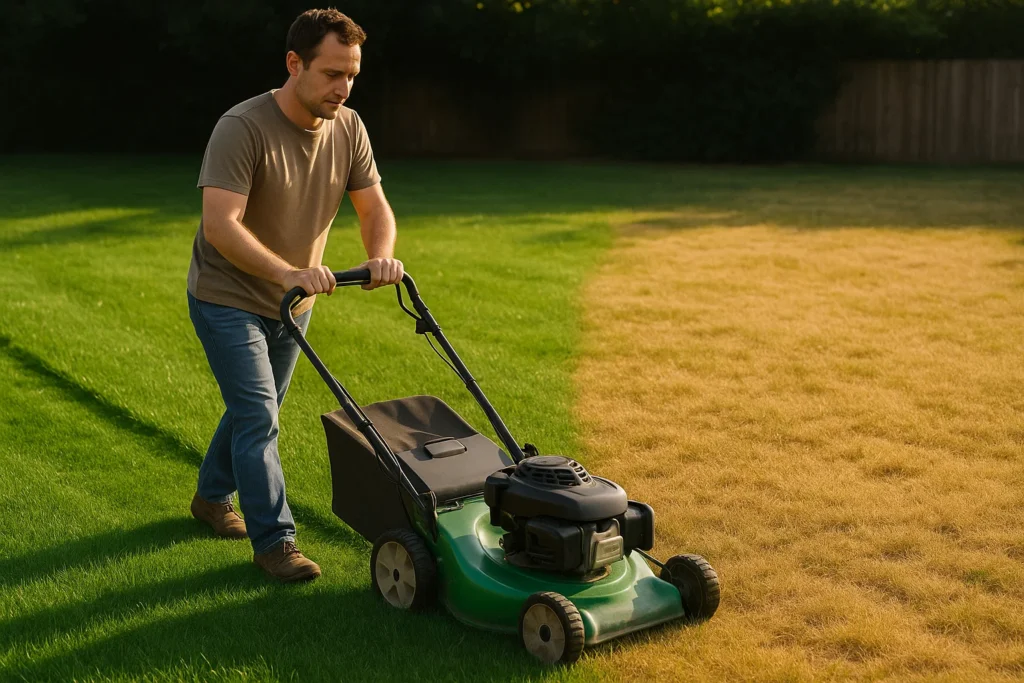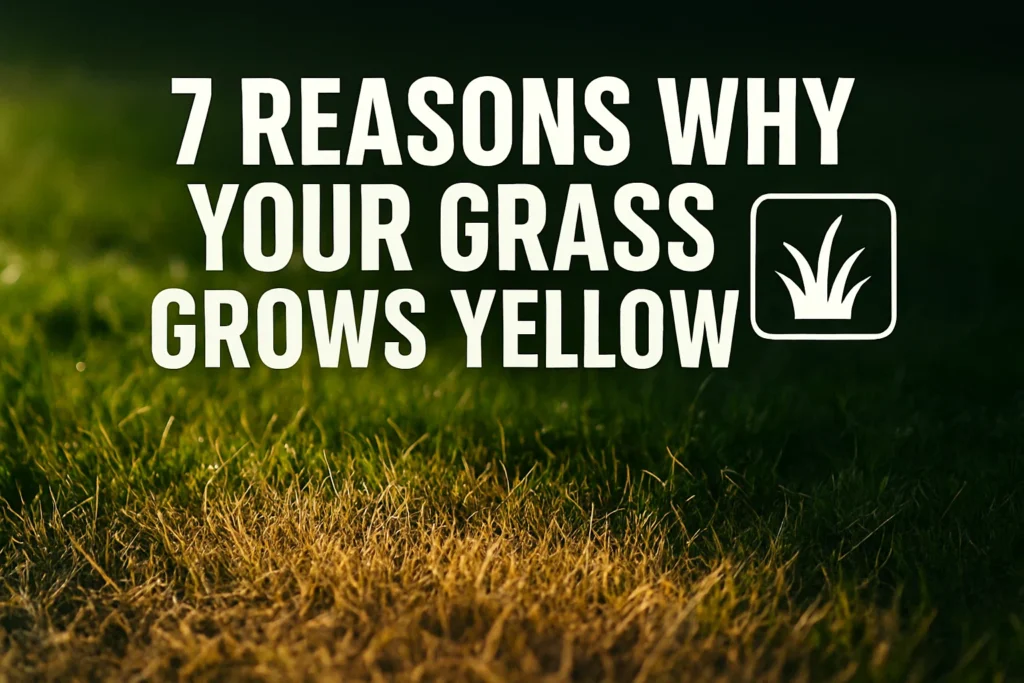One of the most frequent and infuriating issues for homeowners and gardeners is a lawn that is becoming yellow. The yellow grass not only impacts the curb appeal of your property but in many cases, it is the indicator that your lawn is in stress or is experiencing health complications. The first step to having a healthy, green lawn again is to understand why your grass is turning yellow. This article will discuss the primary causes of yellowing grass, the identification of the various types of yellow patches, and the simple ways of making your lawn regain its green color.
Why Is My Grass Turning Yellow?
One of the most frequent problems in lawns is yellowing grass, and it has a lot of causes, not a single solution. The main cause is normally stress to your grass, either due to nutrient deficiencies, watering errors, pests, or environmental factors. This is what could be causing your turf to lose its green lushness:
- Nutrient Deficiency
- Overfertilization
- Water Issues
- Soil Problems
- Pests and Diseases
- Heat Stress
- Improper Mowing
- Animal Damage
Reasons Why Your Grass Is Turning Yellow—and How to Fix Each
Yellow grass is a typical indicator that not everything is okay with the health of your lawn. The reasons may be quite different, starting with mere watering errors and lack of nutrients and finishing with pest attacks and soil problems. These root causes must be understood in order to approach the issue and focus their efforts on it instead of wasting time on short-term solutions. Let’s discuss the most frequent reasons for yellow grass:
Step 1: Poor Soil Nutrition
Lack of nutrients in the soil, particularly nitrogen is one of the main causes of yellow grass. Nitrogen plays a major role in maintaining green and healthy grass blades. In its absence, grass becomes colorless and weak. When you see yellow spots or a yellow lawn, begin with a soil test. It will inform you about the nutrients that your soil requires.
Remedy: Use a fertilizer that is rich in nitrogen. Seek products that are advertised as the best fertilizer to use on yellow grass, and these normally contain a higher proportion of nitrogen in the N-P-K ratio. This is the only thing that can change your grass to green within weeks.
Pro tip: Guessing your fertilizer is not a good idea, test your soil first to prevent over-fertilizing your lawn and burning it.

Step 2: Overwatering or Poor Drainage
Excess water is as bad as insufficient water. When your lawn remains wet or water collects after rain, roots cannot breathe because of the absence of oxygen. This causes root rot and yellowing of the grass.
Solution: Change your watering schedule to prevent overwatering. You can think of aerating your lawn to enhance drainage and oxygen circulation in the soil. Aeration loosens compacted soil allowing roots to breathe and take in nutrients more effectively.
Step 3: Underwatering and Drought Stress
Conversely, underwatering leads to drought stress, and the grass blades become yellow and dry. Lawns require deep watering on a regular basis; shallow watering is usually counterproductive.
Fix: Water early in the morning at 1-1.5 inches a week either by rain or irrigation. Deep watering promotes the growth of roots downwards and makes grass more resistant and green.
Step 4: Pest and Disease Damage
Grubs, chinch bugs or fungal infections are the causes of yellow patches in lawns. You may notice tiny yellow spots or bigger patches in which grass seems to be dead or weak.
Fix: Check your lawn carefully with insects or mold. In case you discover pests or disease, use specific remedies like insecticides or fungicides. Prevention of recurrence will also be done by removing dead grass and enhancing the health of the lawn.
Step 5: Excessive Heat and Sun Exposure
Lawns may be stressed by the summer heat, turning yellow but the yellowing may be temporary. In case you have a lawn species that does not thrive well under direct sun and heat, it will be struggle
Remedy: Sow shade-loving grasses or mulch in the sunniest areas. Also, ensure that watering and feeding are done well to minimize heat stress. A little yellowing in the middle of summer is normal but it must recover with care.
Step 6: Incorrect Mowing Height
Mowing grass too low makes it weak and roots and soil are exposed to sun and heat causing yellowing and poor growth.
Fix: Set mower blades to the suggested height of 2.5 to 3 inches based on the type of grass. Allow grass blades to be longer and shade roots and minimize stress.
Step 7: Weed Competition
The weeds, such as quackgrass and crabgrass compete for nutrients and water. When uncontrolled, they take over your grass leaving your lawn with yellow spots.
Fix: Determine the type of weeds and either manually or by using herbicides, eliminate them depending on the severity. Then overseed bare or thin areas with good quality lawn seed that will match your grass type.
Types of Yellow Grass Patches You Might See
| Patch Type | Description | Likely Causes |
| Large Uniform Yellow Areas | Wide swaths of grass turning yellow gradually | Nutrient deficiency, overwatering, or drought stress |
| Small Scattered Yellow Spots | Small yellow dots or spots spread throughout | Pest damage (grubs, insects), fungal diseases like rust |
| Yellowing Along Edges | Grass edges or patches turning yellow | Soil compaction, poor drainage near borders |
| Yellow Patches With Dead Centers | Yellow ring with browning or dead spot in center | Pet urine burns, fungal infections, or localized damage |
| Irregular Patchy Yellow Zones | Random yellow patches in uneven patterns | Weed infestation (quackgrass, crabgrass), inconsistent watering |
How to Make Grass Greener Again
To repair yellow grass, it is necessary to identify the cause(s) and implement specific solutions. This is a simple step by step procedure:
1. Conduct a Soil Test
A soil test indicates the nutrient content, pH and other valuable soil characteristics that are not visible. Testing is normally provided at low cost by the Local Cooperative Extension services. Make use of the results to select the right fertilizer mix.
2. Fertilize Wisely
Use fertilizer that is rich in nitrogen as per your soil test and type of grass. Do not over fertilize to burn your lawn. Slow-release fertilizers give your grass a steady nutrition that does not shock your grass.
3. Change the Watering Schedule
Water soaks every week or two (about 1 to 1.5 inches total), preferably in the early morning or late evening to minimize evaporation. It is better to avoid excessive shallow watering and saturated soil. Measure the levels of water using tuna cans or small containers.
4. Lawn Aeration
Aeration eases compaction of soil, improves drainage and allows the roots to breathe. A rake, rolling aerator or even rent a powered aerator can be used. This aids in hydrating grass by removing the blockage of water and nutrients in high traffic regions or clay soils.
5. Pest and Disease Control
Look at your lawn often to see whether there are any insects or fungal infections. Treat early using suitable insecticides or fungicides to prevent further damage and recovery.
6. Mow Properly
Mow blades need to be sharp and cutting height should be between 2.5 and 3 inches on most grasses. The longer grass blades cover the roots and the soil to enhance moisture maintenance and tolerance to heat.
7. Control Weeds
Eradicate weeds such as quack grass or crab grass, which take away your turf nutrients and water. Apply herbicides appropriate to your type of grass after which you can uproot them manually and reseed.
8. Guard Against Animal Destruction
Pets are watered to dilute urine or pets should be trained to use specific areas so as to prevent the continuous destruction of the lawn. Fix burned areas by reseeding or sodding.
Seasonal Considerations for Lawn Care to Avoid Yellowing

It is common to find grass turning yellow due to stress and knowing how the seasons impact your lawn can be the difference between keeping your turf green all year round. Every season has its difficulties that your grass must prevail over and hence a change in the routine of caring is important.
- Spring: The lawn is waking out of winter sleep and has to be taken care of with a lot of tenderness and love. Start off with aeration to loosen compacted earth and enhance nutrient flow.
It will be necessary to replenish the nutrients with a balanced fertilizer. Never water too much because spring rains will provide an ample amount. Watch early mowing; too-short cuts may stress the grass and result in yellow turf.
- Summer: The major suspects of yellowing in summer are heat and drought. Grass enters into survival mode and in some cases, grass turns yellow or brown in order to save moisture.
Deep water less frequently, and preferably in the early morning, the water will have less time to evaporate. Set your mower higher-longer grass will shade roots and soil, keeping more moisture in the ground. There should be no heavy fertilizing when the heat is at its peak, as this will burn the grass and contribute to the yellowing.
- Fall: This is the season of recovery of your lawn and storing energy to prepare for winter. Apply a high-phosphorus fertilizer to promote healthy roots, to help grass to take up nutrients during the colder months.
Overseeding and aeration work best in the fall to fill in bare spots and replenish soil health before the next growing season to reduce the risk of yellowing.
- Winter: Grass slows (warm-season grasses) or goes dormant (cool-season grasses) according to the climate of your area.
Yellowing in this case is usually natural, but lessening of foot traffic and the use of fertilizers at this period will ensure that this stress is avoided. Get your lawn ready to spring by clearing debris and aerating, where necessary.
Seasonal lawn care will allow your grass to remain strong, healthy, and less likely to go yellow.
Conclusion
The yellow grass is usually an indication that something is wrong with your lawn and it is attempting to tell you what the problem is, a nutrient deficiency, excess or insufficient water, attack by pests, or environmental stress. A soil test is a better place to start than guessing and monitoring watering patterns. A healthy, lush lawn is composed of healthy fertilizing, watering, aerating, mowing and control of pests. Through patience and proper maintenance your yellow areas of grass can be transformed into fresh and green grass in no time.
FAQs
A: Nutrient deficiencies (mostly nitrogen), incorrect watering, pests, diseases, heat stress, or soil issues are the most common causes. Most problems can be solved by checking the soil and managing its care.
A: Water widely, about 1 to 1.5 inches once or twice a week, best in the early morning or late evenings. Do not have shallow frequent watering or allow soil to remain wet.
A: Yes, most of the yellowing problems can be cured by soil testing and better fertilization, watering, aerating the lawn, and controlling pests or weeds.
A: Certain types of grass are yellow under stress during hot summer months, although this is expected to last only with adequate maintenance.
A: The type of fertilizer to green up the yellow grass is fertilizers containing high nitrogen content, but you should always make your decision based on the soil tests, so that you do not overfertilize.


